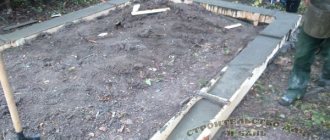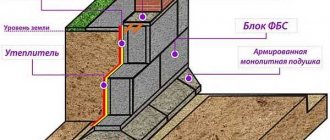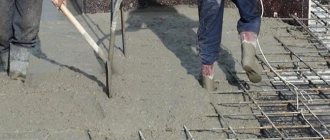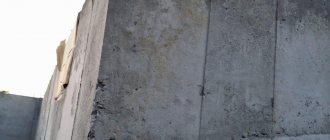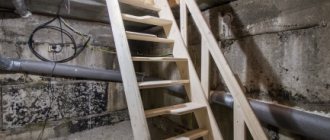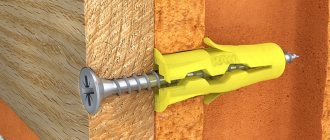Not all country developers understand what a ground floor is - a basement or semi-basement. Let's look into this, after which we will determine for what purposes the premises can be used, what standards exist for the precise definition of the term.
This is what the ground floor looks like Source www.zaggo.ru
What is the difference between a basement and a basement?
In fact, it is not surprising that many do not see the difference in this. Because the purpose of the two rooms is practically the same. It’s just that more often the ground floor is called a semi-basement.
But experts still recommend giving a clearer definition to the basement floor, because this is how you can correctly approach the arrangement of this room, taking into account the required functional features.
So what's the difference? Firstly, both rooms belong to the category buried in the ground: partially or completely. The only difference is in the depth of burial:
- the basement floor is buried below the zero level by less than half its height;
- the basement is buried much lower or completely.
It should be noted that, purely from a functional point of view, both rooms can belong either to the “technical” category, this is when the ceiling height does not exceed 180 cm. Or to the “residential” category, if this parameter exceeds the designated indicator. That is why many owners of small suburban areas plan basements when building a house, subsequently converting them into residential ones. This not only saves land, but also saves money.
The basement is being constructed with complete immersion in the ground Source avatars.mds.yandex.net
Types and features
Residential basement floors can be of different types, with their own characteristics, which distinguish one type from another.
The most popular, main types of plinths in today's buildings are:
- speakers;
- sinking;
- monolithic.
Speakers
This is a traditionally accepted, classic type of plinth device, which allows you to correct any shortcomings made during general construction, or to strengthen part of the foundation of an already used building. This type of base is often not initially planned by the project, but appears later, out of necessity or desire.
When arranging plinths of this type, it is necessary to pay attention to such points as:
- creating a “defensive” outlet or drain behind an external wall;
- maximum fit of the completed elements not only into the internal structure and existing utilities, but also into the appearance of the building.
The difficulty of arranging this type of plinth, in addition to engineering issues, is only one - the cost of building materials, and they can be very noticeable, especially in situations in which general strengthening of the foundation is necessary.
Sinking
This type of plinth may also not have been planned initially, but unlike protruding ones, this type has a much more aesthetically pleasing overall appearance, does not disrupt the perception of the building and does not require high costs for materials.
Such plinths are often installed not so much because of emerging needs. As many as you wish. In principle, this type of floor can be planned initially, during the actual construction of the building.
Monolithic
A monolithic ground floor is a room in a building originally planned at the project development stage, its integral part, both internal and external.
A building with such a plinth looks like a single structure, its external walls are smooth and the dividing line can only be determined by using different finishing materials.
In addition to these main types, there are various architectural subtypes, specific combinations and other features of the arrangement of basement premises, related directly to the specific needs and desires of building owners and the nuances of the landscapes used during development.
How to properly arrange a basement floor
So, having figured out the definition of what a basement floor is, we move on to solving other pressing problems. First, let's start with the features of the room. The thing is that everything will depend on what hopes the owner of the house places on the semi-buried room. This implies two tasks: “minimum” and “maximum”.
Minimum problem
The simplest option is to use the ground floor for rooms in which people will not be constantly present. For example, a sauna, gym, billiard room, garage, etc. That is, you can save a lot of money here, because such premises have more restrained requirements for lighting, heating, thermal insulation of walls, and other things.
Let us make a reservation that according to the norms, people can stay in such premises for no more than four hours.
Billiard room in the basement Source pogreb-podval.ru
Maximum task
If the task is to create living quarters in a semi-basement area. Usually a bedroom, office or rest room is organized here. Then, in this case, the ground floor itself is built according to the building standards of the entire house. Eg:
- ceiling height – at least 2.5 m;
- the width of passages, in this case corridors, is at least 1.2 m;
- The width of the steps of the stairs is at least 25 cm, their height is no more than 19 cm.
It is necessary to have daylight, ventilation and other communication networks.
Living room in the basement Source www.byrneseyeview.com
See also: Catalog of projects of houses with a basement floor
Completely or partially underground
Let's start by looking at all the types of premises that interest us from the point of view of their location. Very often, the underground floor is considered a basement, and the basement is called the basement.
- Probably, there is nothing terrible in this confusion until the determination of the purpose of the premises in the BTI passport begins, and the price of the issue becomes clear.
- Depending on the status of the underground premises, it may be included in the taxable area or not taken into account as utility premises.
- Tax rates may change, but the type of underground structure of a building is a fairly stable concept.
On a note! As a result of the difference in relief on the site, the lower part of the building on one side can be defined as a basement, and on the opposite wall as a basement.
In areas with complex terrain, the same room can be defined differently from different sides of the house
100% underground
This type of premises is now quite rare in private construction, since the use of such premises can be very limited. But in multi-storey standard buildings, more and more often houses have at least one, and more often two, underground floors. Their area usually contains parking lots and storage rooms.
Factors influencing the complexity and cost of work
What is the basement floor in a house? These are recessed rooms. This means that their walls will be in direct contact with the ground. That is, there will be constant humidity inside the space being organized. Many people know firsthand what this means.
But if all construction work is carried out strictly according to the rules and regulations, then this trouble can be avoided without any problems. To do this, high-quality waterproofing of the walls of the basement and its floor base is done.
But if fungus or mold colonies appear on the walls and ceiling, then the problem is not the waterproofing, but poor ventilation. At the same time, violations were made when the thermal insulation layer was laid. This is where the huge financial costs are. Therefore, at the stage of construction of the basement floor, all its elements must be covered with high-quality hydro- and heat-insulating materials without violating installation technologies.
Hydro- and thermal insulation of the basement floor Source www.zaggo.ru
Of course, we must pay tribute to the type of soil on the construction site, as well as the level of groundwater. These two parameters directly affect the humidity inside the basement. The lower the ground level, the drier the inside. The more porous the soil, the drier it is. For example, if the soil in the area is sandy, then there is a high probability that precipitation will not accumulate in it, but will move down to the groundwater. Therefore, constructing semi-basement spaces on such soils is much easier and cheaper.
The situation is worse if the soils on the building site are impermeable, that is, clayey. Even if the groundwater level is low, it is still a problem area. And here you will have to invest serious money to ensure maximum protection of the basement from moisture.
And the most unpleasant situation is if the GWL is high. Many developers even refuse to have a semi-basement or basement in the house. The costs of its formation are too high. Especially if the site needs to be dewatered.
What problems need to be solved?
Several factors have a decisive influence on the cost and complexity of the work on arranging a basement or basement.
High humidity
Humidity in basements is a very common phenomenon, however, you should not be afraid of it, you just need to eliminate the possibility of moisture penetration from the very beginning of construction. As a rule, this can be achieved by making high-quality waterproofing, including floor waterproofing.
The situation is much worse when mold or mildew subsequently appears on the walls. This indicates a lack of sufficient ventilation of the premises, as well as loose or damaged waterproofing of the external walls and their insufficient thermal insulation. The volume and cost of work required to eliminate deficiencies is quite high.
Insulation and waterproofing of the basement floor
The groundwater level and the type of soil on which the building is erected are also closely related to the moisture status of the walls and floors in the basement. With sandy soils and groundwater lying below the level of the basement/basement, they are usually dry. This means that even a serious amount of modernization work (for example, arranging a cellar in the basement) is unlikely to be too cumbersome and expensive. Especially when the main construction work will be carried out in the summer.
The situation is much worse when the site has impermeable soils (clayey) - in this case, even despite the low groundwater level, the basements can be very wet. The reason for this is water seeping through the soil and collecting near the foundation walls (in the area of the former pit). In such moments, it is necessary to carry out drainage, and this, of course, increases the cost.
The worst thing is when the groundwater is above the foundation level of the building. In this case, the arrangement of both the ground floor and the basement (in particular) is associated with a number of difficulties. The house must have sealed waterproofing of the highest possible quality, plus separate work may be required to drain the area.
The waterproofing of the basement floor is described in an interesting and accessible way in the video:
It is also a difficult situation when the walls in the basement are dry and crumble when touched. This means that they can be so damaged by moisture and frost that their strength is significantly lower than designed. And then in addition to the insulation work, additional measures will be added to strengthen the load-bearing structure of the building, which is very difficult and expensive.
Lighting
Availability of daylight is another difference between the basement and the basement. It is especially necessary in living rooms. It must be borne in mind that the window area must be at least 1/8 of the floor surface, and in rooms not intended for permanent occupancy of people, at least 1/12. This is, as a rule, much more than what ordinary, small basement windows provide.
They are designed more to improve ventilation than to properly illuminate rooms. In this case, the width of the openings is very important. The windows should be at least 90 cm (preferably 120 cm), in which case the lighting situation will be quite favorable.
Recreation room in the basement
Height
Basement height - this factor is very important when determining how to arrange additional space. In most projects it is about 220 cm, which allows the design of premises intended for temporary occupancy of people. However, for many investors this limitation is not an obstacle. By raising the walls of the basement by 30 cm, you can get a basement adapted for residential needs. The height is sufficient to create various recreation rooms or bedrooms in the basement, that is, to increase the living space.
Warmth in the basement
Heating additional rooms is not a problem if an appropriate heating system is initially provided (which, as a rule, is the case during construction of the building). However, if this was not provided for, then it is worth keeping in mind that in warehouse premises the temperature in the range of 5-8°C is sufficient, in those designed for temporary stay - 12-16°C, and in residential premises 18-22°C .
Of course, short-term heating of rooms, for example, using portable electric heaters, is acceptable and cost-effective, but for continuous heating of a larger volume, you will need appropriate reserves in the heating system or a separate heating installation.
Plumbing
Sauna with Jacuzzi in the basement
In basements, plumbing and sewerage are used quite often. The installation of a bathroom, toilet or kitchen is associated with water supply and wastewater disposal. However, while supplying running water to both the basement and the basement is generally not a hassle, installing an additional section of sewer in the basement may create some problems. Because, as we know, liquids do not flow into mountains and deep basements, the installation of an appropriate pump will almost certainly be required, which increases the cost of the entire system.
Electricity
The design of the electrical system is most often not too complicated or expensive. Almost anyone can handle installing a few extra bulbs and contacts. Even with the possible installation of electric heated floors. You just need to check whether the network power is sufficient for the amount of energy consumed.
Quite often it happens that the number of additional electrical appliances (stoves, ovens, air conditioners, freezers, computers, heaters, etc.) is so large that it is necessary to replace the entire system. It is better to take this into account before starting construction work.
Ventilation
Proper ventilation of rooms equipped in basements is necessary. The ground floor is no exception. Otherwise, in a short time, due to increased humidity, fungus may form on the walls, so it is advisable to ensure an influx of fresh air and removal of exhaust air. It should, however, be borne in mind that for this, vents in the windows are not enough; it is necessary that exhaust ducts, common to the entire house, go into the basement. The best, but also the most expensive, solutions include, of course, mechanical ventilation systems. However, in many cases you can do without them. You just need to contact an experienced ventilation system specialist.
All of the above points are best resolved at the design stage and at the beginning of construction, then later you will not have to resort to expensive repairs. When it comes to the practicality of basements, both a basement and a basement are a great way to increase usable or living space, and this makes sense even in very spacious homes.
Briefly about the main thing
The ground floor differs from the basement in that it is not completely buried. That is, if the question is, the ground floor - what is it, you can safely answer - it is a semi-basement.
If the ceiling height in the semi-basement is up to 180 cm, then this is a technical floor. If 250 cm and above, then you can organize living quarters.
The main task is to create conditions under which humidity does not increase on the ground floor. Therefore, special attention is paid to waterproofing the room and creating an efficient ventilation system.
If it is necessary to organize sewerage, then a sewage pump must be installed.
Can the basement be considered the fourth floor?
According to Article 48 of the Civil Code of the Russian Federation, restrictions are provided for private, individual buildings. And it clearly states that the height of cottages in Russia cannot exceed 3 floors.
Otherwise, this is no longer an individual housing construction project (individual housing construction). And completely different requirements apply to it (as to residential complexes). If you built/bought such a house on private housing construction land, you will not be able to legalize it, and most likely you will have to demolish a floor or even the entire building.
Important: By law, the maximum height of single-family cottages is limited to 3 floors.
Are the basement and basement considered floors?
Yes, if their ceilings and floors protrude 2 meters or more above the ground.
Are the basement and basement counted in the total number of storeys of the house?
Yes.
The terms “number of storeys” and “number of floors” are enshrined in Article 49 of the Town Planning Code of the Russian Federation. According to it, the number of floors is considered to be the totality of all types of premises - technical, underground, basement, basement, above-ground and attic.
About 10-15 years ago, some developers, taking advantage of the inexperience of buyers, “cunned” and built their properties, violating these norms, offering, under the guise of 3-story houses, actually 4-story buildings. However, over time, buyers became more educated and stopped buying them, so most of these construction sites remained vacant lots and “unfinished”, which can often be observed in the suburbs of any large Russian city.
What are they guided by when determining the number of storeys of houses?
From a visual point of view, the number of floors is usually calculated based on the number of windows above the ground. Technically, it is believed that a full floor is a level whose ceiling is located above the ground.
In order for the basement to be included in the living area of the house, its ceiling must be located above ground level. If the ceiling (floor) is located below, then such premises are already included in the living area, but may or may not be included in the common area.
Let's look at these concepts in more detail.
When drawing up documentation, specialists indicate its number of floors in the object’s passport. In addition to this indicator, the number of underground premises is also indicated, which are divided into:
- socle (ground floor);
- basement;
- boiler room;
- cellar;
- technical rooms, etc.
Example: in the column “Number of floors” the number 3 is indicated, in the column “Underground floors” they are written 1, and the number of storeys of the house is the difference between these two indicators. Therefore, the house is considered to be two-story.
Why does the number of floors in a house play an important role?
Firstly, as we described earlier, some unscrupulous sellers and developers may wishful thinking - that is, when specifying the living space in the contract, include basements, low plinths, technical premises, etc.
Secondly, depending on the total area of the building, the owner may pay less property tax. Therefore, if you do not plan to use technical floors, it is worth building them in accordance with the technical parameters. Then they will not be included in the total area of the house.
How are the basement and basement taken into account in the BTI?
On the Internet and on forums, owners of country cottages often write that when examining their basement floors by experts from the technical inventory bureau, the following are first taken into account:
- ceiling height;
- presence of windows in the rooms.
This means that the lower floor, protruding high above ground level, may well be considered by BTI specialists to be full-fledged, even if you do not plan to use it in the future.
A large number of different interpretations and discrepancies in different authorities does not allow us to put an end to this issue. We recommend taking into account SNiP standards when planning the construction of a residential building, and if there are doubts or unusual situations, request appropriate clarification from the local administration.
What other requirements apply to houses under individual housing construction?
In the Town Planning Code, the definition of the concept of an individual housing construction object (IHC) includes buildings with residential and auxiliary premises that are necessary for the full functioning and life of a person in the house (clause 3, article 48).
If the cottage meets the above parameters and has no more than 3 floors, then you will not have to create design documentation for it, even if you decide to renovate, reconstruct or overhaul it.
A ban on living in a private house can be made only in one case: if, as a result of an examination, the building was found to be in disrepair or unsuitable for permanent residence.
Accordingly, owners can convert the basement and basement floors as they please and even live in them, if they are built taking into account all standards.
In general, when inspecting any residential buildings, BTI employees are usually guided by SNiP regulations. Therefore, in order to build a house without violations and put it into operation, you must first become familiar with them. The architectural department can bring you up to date when issuing a building permit at the local administration.
As a rule, the requirements of construction legislation remain almost unchanged over the years. Because the regulations were created to ensure the safety and long-term operation of real estate. If you are not ready to study these regulations yourself, it is better to contact a specialized company that will create a house project taking into account your wishes and legal requirements.
